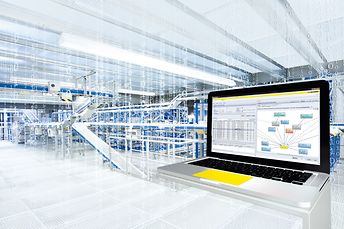Intralogistics 4.0
In the case of Industry 4.0 (or the Fourth Industrial Revolution, as it is more commonly known outside Germany), it is legitimate to ask how much is genuine innovation, and how much is simply clever marketing. And it is even more justified when it comes to Intralogistics 4.0. This blog post attempts to answer that question and to describe what we can truly expect from 4.0.
There are many definitions for Industry 4.0, but all include the following core attributes:
1. Connectivity between and integration of machines, sensors, and other (manufacturing-related) equipment
2. The deployment of Internet technologies.
The first of these was described back in 1973 and made waves in the 1980s under the abbreviation CIM. For this reason, it is not unusual for Industry 4.0 to be described as an old idea – simply repackaged.
An old idea repackaged?
There is an element of truth to the criticism. But Industry 4.0 is a bit more than just a new name for a familiar concept. There is far more to the seemingly simple statement “deployment of Internet technologies” than TCP/IP and HTML.

With regard to the Fourth Industrial Revolution, the expression “Internet technologies” goes beyond a collection of existing communications and connectivity standards. The Internet is about enabling communication, exchange and collaboration. And that is exactly the goal of the Industry 4.0 initiative – to add these elements to manufacturing.
Today, we are accustomed to combining functions and services from multiple providers on Internet platforms; applying this approach to manufacturing simply goes a step further. But before I delve into the intrinsic challenges posed by the implementation, we’ll explore the differences between Industry 4.0 and Intralogistics 4.0.
Industry 4.0 vs. Intralogistics 4.0
In essence, the core attributes are identical – they are just employed for different purposes. The focus of Intralogistics 4.0 is on streamlining the supply chain, while Industry 4.0 is mainly about manufacturing. Without effective communication in place, supply chains would fail. Consequently, intralogistics and logistics are further evolved in terms of 4.0 than manufacturing. And that often begs the question: what exactly is new about Intralogistics 4.0?
To arrive at an answer, we can examine the inherent challenges related to these issues. First, let us consider a seemingly banal example. If I ask: “Do you know what the time is?” You, being a polite person, would not simply reply “yes.” Instead, you would state the current time. In other words, you would have understood and intelligently interpreted my question, and helpfully answered it.
However, if I had asked you: “Nǐ zhīdào zhè shì shénme shíhòu?”, you would have probably shrugged your shoulders, or inquired: “Sorry, what was that? In order to communicate, we need a common language. We would also fail to communicate if we lacked a common medium – for example, the coding used to transmit a signal or, more simply, the piece of paper upon which a recognizable script is written.
Rising to the challenge
There are naturally a number of hurdles to scale in communication and comprehension before this vision can be realised across multiple devices and vendors. But software-as-a-service (SaaS) offerings on the Internet show that it is possible. The technology is already available – and we can draw inspiration from successful instances in other fields (for example, the combination of customer relationship management (CRM) software from vendor A with a newsletter tool from vendor B and office software from vendor Call in the cloud).
At this point, it would be inappropriate and ill-judged to suddenly require an international standard for language and meaning across all processes in the supply chain, simply for the sake of Intralogistics 4.0. A project of such colossal scale and complexity would flounder. However, this should not hold us back from creating standards within clearly defined areas. That means Intralogistics 4.0 will manifest itself in various ways and in many areas within the supply chain. And since we have the technologies and blueprints to see it through, the first seeds of 4.0 in intralogistics will, hopefully, soon be bearing fruit.